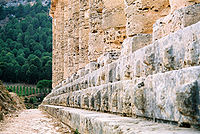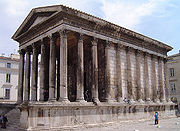
Stylobate
Encyclopedia


Architecture of Ancient Greece
The architecture of Ancient Greece is the architecture produced by the Greek-speaking people whose culture flourished on the Greek mainland and Peloponnesus, the Aegean Islands, and in colonies in Asia Minor and Italy for a period from about 900 BC until the 1st century AD, with the earliest...
, a stylobate is the top step of the crepidoma
Crepidoma
Crepidoma is an architectural term related to ancient Greek buildings. The crepidoma is the platform of, usually, three levels upon which the superstructure of the building is erected. The levels typically decrease in size incrementally, forming a series of steps along all or some sides of the...
, the stepped platform on which colonnades of temple column
Column
A column or pillar in architecture and structural engineering is a vertical structural element that transmits, through compression, the weight of the structure above to other structural elements below. For the purpose of wind or earthquake engineering, columns may be designed to resist lateral forces...
s are placed (it is the floor of the temple). The platform was built on a leveling course that flattened out the ground immediately beneath the temple.
Some methodologies use the word stylobate to describe only the topmost step of the temple's base, while stereobate is used to describe the remaining steps of the platform beneath the stylobate and just above the leveling course. Others use the term to refer to the entire platform.
The stylobate was often designed to relate closely to the dimensions of other elements of the temple. In Greek Doric temples
Doric order
The Doric order was one of the three orders or organizational systems of ancient Greek or classical architecture; the other two canonical orders were the Ionic and the Corinthian.-History:...
, the length and width of the stylobate were related, and in some early Doric temples the column height was one third the width of the stylobate. The Romans
Roman Empire
The Roman Empire was the post-Republican period of the ancient Roman civilization, characterised by an autocratic form of government and large territorial holdings in Europe and around the Mediterranean....
took a different approach in their interpretation of the Corinthian order
Corinthian order
The Corinthian order is one of the three principal classical orders of ancient Greek and Roman architecture. The other two are the Doric and Ionic. When classical architecture was revived during the Renaissance, two more orders were added to the canon, the Tuscan order and the Composite order...
, using a much loftier stylobate that was not graduated except in the approach to the portico
Portico
A portico is a porch leading to the entrance of a building, or extended as a colonnade, with a roof structure over a walkway, supported by columns or enclosed by walls...
.

